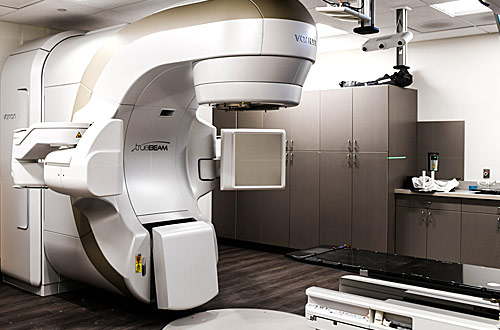

We offer patients a wide range of advanced radiation treatments at our Red Lion Plaza cancer center. Using the TrueBeam™ radiotherapy system, our radiation oncologist works with a team of radiation therapists, dosimetrists, and physicists to target treatment of tumors with remarkable precision – maximizing cures while minimizing side effects.
The TrueBeam™ radiotherapy system can:
- Customize treatment for precise radiation doses
- Lessen harm to surrounding tissue and normal cells
- Reduce treatment times and discomfort
- Minimize side effects
External Radiation Therapy
3-D Conformal Radiation Therapy Three-dimensional conformal radiation therapy (3D-CRT) uses computers, CT scans, and MRI scans to create detailed, three-dimensional representations of the tumor and surrounding organs. Nearby normal tissue receives less radiation exposure because the radiation beams are targeted directly at the tumor.
Intensity-Modulated Radiation Therapy (IMRT) Intensity-modulated radiation therapy (IMRT) is an advanced form of external radiation treatment that allows precise targeting of tumor cells. With IMRT, the radiation oncologist specifies the dose desired to give the tumor and the doses acceptable to the normal tissues (as low as possible).
Image-Guided Radiation Therapy Image-guided radiation therapy (IGRT) combines three-dimensional images with the precise technology of either 3-D or IMRT to pinpoint and treat cancerous tumors. IGRT is used to treat tumors in areas of the body that are prone to movement, such as the lungs, liver, and prostate gland, as well as tumors located close to critical organs and tissues.
Intensity-Modulated Arc Therapy (IMAT) Intensity-modulated arc therapy (IMAT) is the use of IMRT delivered to the targeted area while the arm of the linear accelerator is in motion around the patient, resulting in multiple radiation beams being delivered to the specific tumor area more rapidly. This new technology reduces treatment times by as much as 80%, minimizing discomfort to the patient.
Surface-Guided Motion Management A surface image guidance system for patient and accessory setup, interfraction positioning, and intrafraction patient motion management. It is used during CT simulation and radiation therapy. Stereo vision cameras compute a live video feed of the patient, indicating posture changes needed to bring the patient into alignment. During treatment, if the patient’s position deviates from predefined offset thresholds, the beam can be automatically turned off.
Stereotactic Radiotherapy (SRS/SRT) Stereotactic radiosurgery (SRS) is a type of radiation therapy that can be used in place of or in conjunction with surgery for single tumors that have spread to the brain. It is given in one to five sessions, although the treatment can be repeated if necessary.
Stereotactic Body Radiation Therapy (SBRT) may be used for certain lung, spine, and liver tumors.
Respiratory Gating Movement (RPM) Respiratory gating involves continuous monitoring using video imagery of tumor movement due to breathing during radiation therapy. It allows the cancer treatment specialists to ensure they are correctly targeting the radiation beams in the abdomen or chest, administering radiation only when the tumor is in the correct treatment zone.
